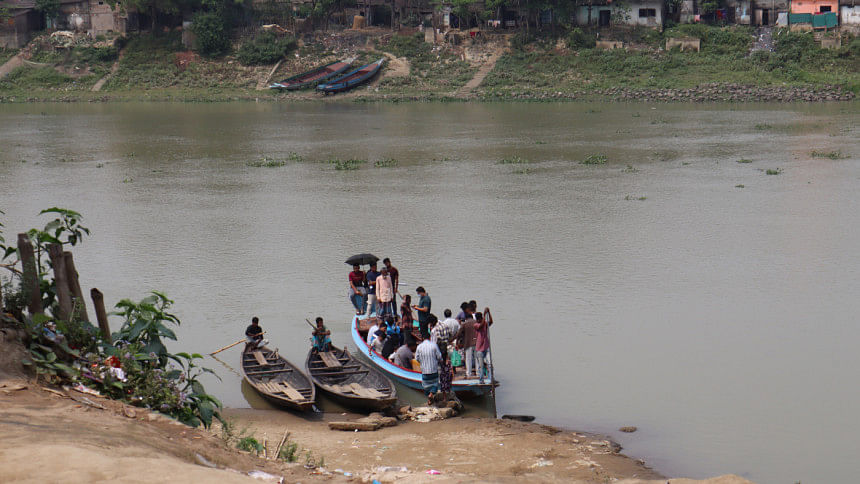Kushiyara River: Promises made, decades passed, no bridge built

"Since I was 12, I've been hearing that a bridge over the Kushiyara river will be built here," said Nepal Ranjan Das, 55, a resident of Bilbari in Rajnagar upazila of Moulvibazar. "Whoever comes to power promises the bridge -- but nothing happens."
This long-standing frustration is shared widely among locals. Talking to 13 residents in the area, nearly all voiced similar concerns over the delayed bridge project.
Balaganj Kheyaghat is located in Fatehpur union of Rajnagar upazila in Moulvibazar. However, locals have far more frequent interaction with Balaganj upazila in Sylhet, situated just across the Kushiyara. Students from the Rajnagar side regularly attend schools and colleges in Balaganj, and many residents depend on the Balaganj Upazila Health Complex due to its proximity.
Geographically, the Kheyaghat area lies on the northern edge of Rajnagar. While the upazila headquarters is nearly 15 kilometres away, Balaganj is easily reachable by a short river crossing. As a result, the Sylhet town has become the preferred destination for education, healthcare, and trade for locals.
Despite promises from successive governments spanning four decades, no bridge has yet been constructed over the Kushiyara River at Balaganj Kheyaghat -- an important crossing that links Rajnagar upazila with Balaganj in Sylhet.
Each day, more than 10,000 people -- including students, patients, and traders -- cross the river by boat. While river conditions are manageable during the dry season, monsoon turns the crossing perilous. Turbulent waters and strong currents pose daily risks, especially for children and the elderly, said locals.
Rajat Das Bhulan, a trader from Balaganj Upazila Sadar, said people from at least 50 villages in Fatehpur, Uttarbhag, Panchgaon and Munshibazar unions of the Kawadaghi Haorpar area depend on Balaganj for various necessities.
The Rajnagar-Balaganj road, which connects to Kheyaghat, serves as a vital link for communities across both upazilas and neighbouring haor areas. However, with no bridge, river crossings rely on two engine boats and around 20–25 small boats operating daily from early morning to late at night.
"The river becomes rough during monsoon," said Ismail Ali of Hamidpur. "Every year, one or two boats sink. Students cross this river daily. We've been hearing promises about a bridge for over a decade," he said.
Md Kaysar Hamid, executive engineer of the Roads and Highways Department in Moulvibazar, said a survey for the main bridge has been completed and design work is currently underway.
A consultant firm, the Institute of Water Modelling (IWM), is conducting a study to determine the alignment of the approach roads on both sides, he said.

 For all latest news, follow The Daily Star's Google News channel.
For all latest news, follow The Daily Star's Google News channel. 



Comments